Imagine robots evolving from mindless machines to smart partners. They’re not just following orders anymore—they’re learning, adapting, and making decisions on their own. From manufacturing floors to healthcare, autonomous machines are reshaping how we work and live. Think less sci-fi dystopia, more intelligent collaboration. They’re sensing, analyzing, and responding in real-time, blurring the lines between human and machine. Curious about what comes next? Stick around.
The First Mechanical Minds
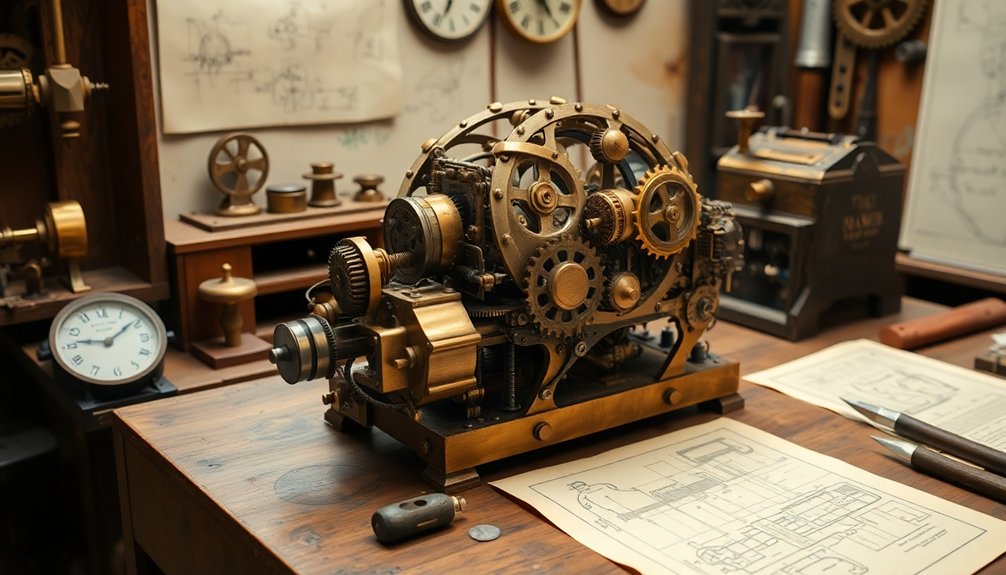
Since humans first dreamed of creating life-like machines, the quest for mechanical minds has been wild and weird.
Ancient cultures were obsessed with bringing inanimate objects to life. The Greeks had Hephaestus crafting magical automatons, while Egyptian priests rigged oracle statues with hidden mechanisms to freak out worshippers.
Babylonians built water clocks that ticked and moved like primitive robots. Homer wrote about mechanical creatures in the Iliad, and Archytas even constructed a steam-powered mechanical bird that could actually fly. In 9th century China, Han Zhile’s automata demonstrated remarkable engineering skills that would lay the groundwork for future robotic innovations.
Pioneers of Autonomous Motion
Three key pioneers turned the crazy dream of self-moving machines from sci-fi fantasy into real-world technology. Early autonomous robotics research emerged from laboratories that saw machines not as static tools, but as potential adaptive systems. William Grey Walter’s electronic tortoises, Victor Scheinman’s precise robot arm, and Tony Sale’s scrap metal humanoid proved that autonomous motion wasn’t just imagination—it was possible. Neural network architectures would later build upon these foundational designs, transforming robotic capabilities beyond simple mechanical movements.
| Pioneer | Innovation | Impact |
|---|---|---|
| Walter | Autonomous Tortoises | Neural network simulation |
| Scheinman | Stanford Arm | Industrial robotics revolution |
| Sale | Humanoid George | Early human-like mobility |
These innovators didn’t just build machines; they rewrote the rules of what technology could do. Walter showed robots could navigate using simple neural networks. Scheinman transformed manufacturing with electric motor precision. Sale demonstrated that even crude humanoid designs could move with purpose.
Their work wasn’t about creating perfect machines, but proving that autonomy could emerge from clever, minimalist design. Who knew scrap metal and basic electronics could birth the future?
Industrial Revolution in Robotics
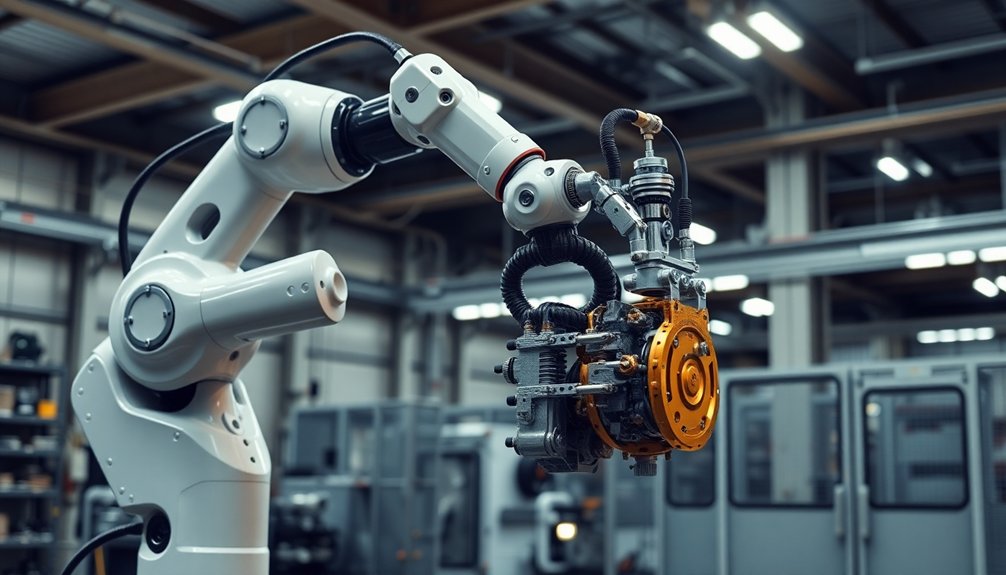
When General Motors dropped its first industrial robot onto the factory floor in 1961, nobody realized they were about to spark a manufacturing revolution that would remake how humans work.
Those early robot arms weren’t just fancy machines—they were workplace heroes, rescuing humans from dangerous, mind-numbing tasks like lifting scorching metal parts and stacking 75-pound loads.
The Unimate robot didn’t just work; it transformed factories from risky human zones to precision performance stages. Global robotic installations would eventually grow to nearly 422,000 units by 2018, demonstrating the massive technological shift.
By the 1980s, these mechanical marvels had become assembly line rockstars, doubling production rates and slashing workplace injuries.
Welding, painting, assembling—robots did it all, faster and more consistently than their human counterparts.
Who knew chunks of metal and wiring could become such game-changing workplace partners?
Computational Intelligence Emerges
You’re witnessing the moment machines start thinking like curious kids, not just following rigid instructions—computational intelligence is basically teaching robots to learn from experience instead of memorizing dusty rulebooks. Computational systems are now exploring advanced techniques like fuzzy logic and neural networks that enable nuanced decision-making beyond binary constraints. Neural networks and evolutionary algorithms are now letting machines recognize patterns, make wild guesses, and adapt faster than a chameleon changing colors in a disco. Imagine algorithms that can reason, predict, and solve problems by mimicking how your brain works, turning cold silicon into something that almost—just almost—looks like genuine intelligence. Neuromorphic computing is revolutionizing machine learning by mimicking human brain structures, creating adaptive systems that can process information more dynamically and intuitively.
Algorithmic Learning Breakthroughs
As computational intelligence leaps forward, algorithms are transforming from rigid instruction-followers into dynamic learning machines that can think, adapt, and solve problems in ways we’re just beginning to understand. Neuromorphic computing is pioneering brain-like machine thinking that mimics human cognitive processes.
You’re witnessing a revolution where AI isn’t just crunching numbers, but actually learning and improvising like a digital brain on steroids. Imagine algorithms that can detect hidden biases, generate mind-blowing videos, and even predict traffic patterns better than your GPS-obsessed uncle.
These aren’t sci-fi fantasies—they’re happening right now. Neural networks are getting so smart they’re practically reading your mind, processing unstructured data like it’s child’s play.
From autonomous vehicles maneuvering complex city streets to AI systems that can outperform humans in programming challenges, we’re not just coding machines anymore. We’re teaching them to think.
Machine Reasoning Evolution
Imagine computers that can actually think, not just calculate. From Turing’s early tests to today’s generative AI, machines have transformed from rigid rule-followers to dynamic learners. They’ve gone from playing chess to understanding complex language, predicting outcomes, and even creating art. Deep learning cracked open a whole new world where neural networks can recognize patterns humans might miss. Narrow AI technologies have demonstrated remarkable precision in specialized robotic tasks, showing how computational intelligence is progressively bridging the gap between programmed responses and adaptive learning. Think of it like teaching a robot to see the world not just as pixels, but as meaningful connections. The leap from simple algorithms to nuanced reasoning is less about programming and more about creating systems that can adapt, learn, and surprise us. Who’s really in control here?
Breaking Beyond Programming Limits
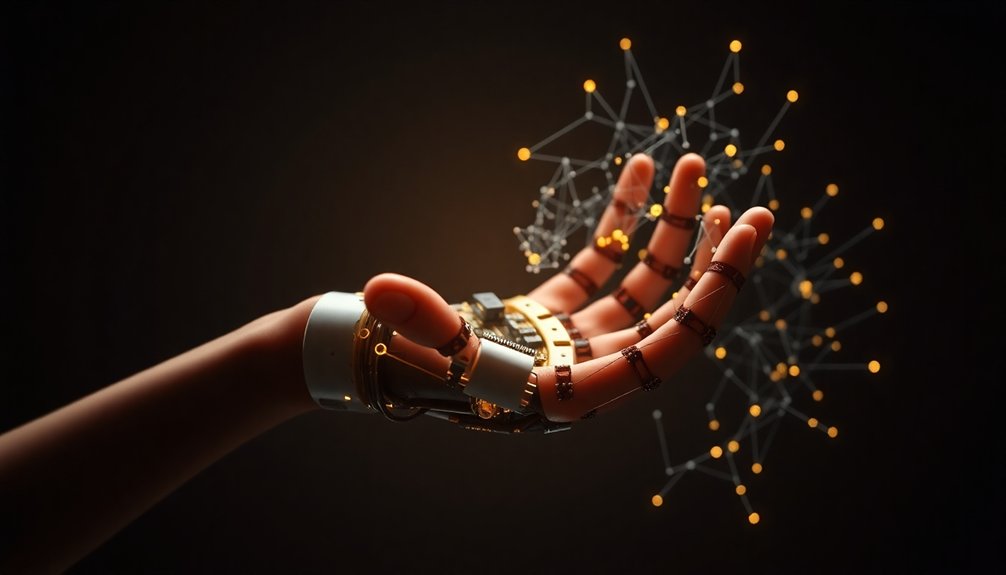
You’ve heard robots can follow instructions, but what happens when they start writing their own rulebook?
Imagine machines that don’t just execute code, but dynamically adapt, learn, and optimize themselves in real-time – transforming from predictable automatons into cognitive chameleons that reshape their own capabilities. Reinforcement learning technologies enable robots to develop sophisticated movement patterns by continuously analyzing and improving their own performance through digital trial-and-error simulations.
The frontier of autonomous machines isn’t just about smarter algorithms, it’s about creating systems that can fundamentally reimagine their operational constraints, turning rigid programming into fluid intelligence.
Adaptive Learning Capabilities
How do machines learn to think beyond their original programming? Imagine robots transforming from rigid automatons to flexible learners, absorbing knowledge like digital sponges.
They’re breaking free from pre-programmed constraints, developing adaptive capabilities that blur the line between instruction and intuition.
- A warehouse robot learns to redistribute workload when a teammate malfunctions
- A kitchen assistant seamlessly switches from chopping vegetables to loading dishwashers
- A quadruped robot adjusts its gait dynamically across uneven terrain
- An AI system updates its strategy based on real-time environmental feedback
These machines aren’t just following rules anymore—they’re interpreting, predicting, and evolving.
By consuming multimodal data and continuously refining their approach, autonomous systems are transforming from obedient tools to intelligent collaborators.
They’re not just executing tasks; they’re understanding context, anticipating needs, and making split-second decisions that would make traditional programming look like child’s play.
Cognitive Flexibility Emergence
Because cognitive flexibility isn’t just another tech buzzword, it’s the secret sauce turning machines from predictable robots into adaptable thinking partners.
You’re witnessing AI’s evolution from rigid programming to fluid intelligence—where systems don’t just follow rules, they reinvent them on the fly. Imagine machines that learn like jazz musicians improvising, switching contexts faster than you can blink.
They’re deconstructing complex problems, recognizing multiple solution paths, and updating beliefs in real-time. The breakthrough? These systems aren’t stuck in one mental groove.
They’re dynamic learners that can pivot between tasks, absorb new information, and collaborate seamlessly with humans. It’s not about replacing human creativity—it’s about amplifying it, creating a symbiotic dance of silicon and synapse that transforms how we solve problems.
Self-Optimization Strategies
When machines break free from their original programming, something magical happens: they start learning how to learn. Self-optimization isn’t just fancy tech talk—it’s machines evolving beyond their initial constraints, becoming smarter with every interaction.
- Imagine robots sensing their environment and instantly adjusting movement, like a gymnast mid-flip.
- Picture AI redesigning its own neural networks to solve problems faster.
- Envision microreactors autonomously tweaking chemical reactions in milliseconds.
- Watch predictive systems diagnose equipment failures before humans even notice.
These aren’t sci-fi fantasies; they’re happening right now. Your autonomous machines are transforming from rigid tools into adaptive partners, constantly learning, improving, and surprising even their creators.
The line between programmed response and genuine intelligence? It’s blurring fast—and that’s both thrilling and slightly terrifying.
Sensing and Adapting to the World
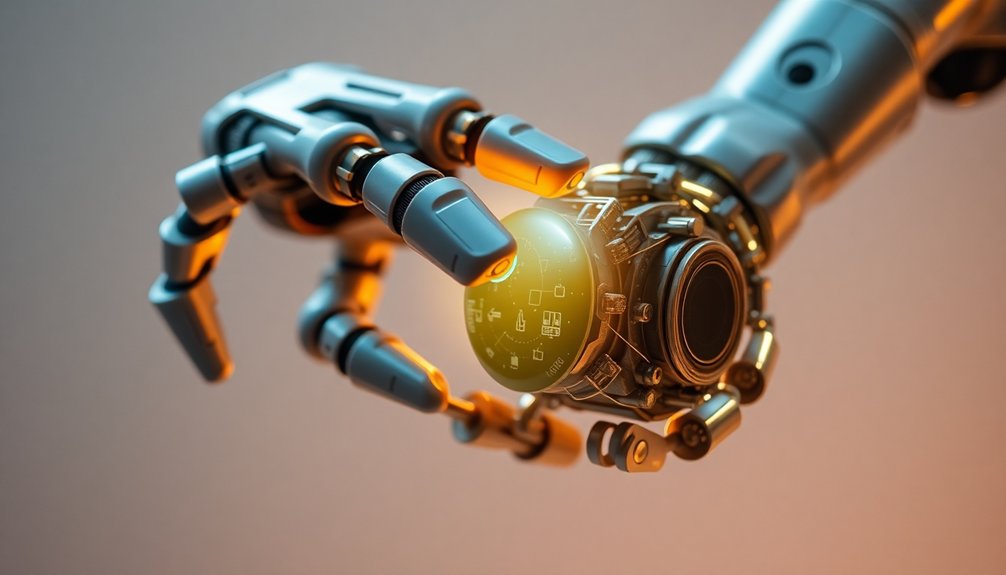
Autonomous machines are learning to sense and adapt to the world in ways that would’ve seemed like science fiction just a decade ago.
Imagine robots with superhuman senses that can hear, see, and feel their environment more precisely than humans ever could. They’re using nanoscale sensors that mimic our basic sensory inputs, combining technologies like LIDAR, GPS, and AI to create a hyper-aware mechanical brain.
These aren’t just dumb machines anymore—they’re becoming intelligent partners that can track motion, analyze complex environments, and make split-second decisions.
Whether it’s a farming robot detecting soil moisture or a surveillance system spotting urban anomalies, these machines are transforming from clunky tools into adaptive, context-aware assistants that learn and respond in real-time.
Collaborative Machine Intelligence
You’ve probably wondered how robots might work together without turning into a sci-fi apocalypse scenario – and that’s where collaborative machine intelligence gets seriously interesting.
Imagine robots learning from each other in real-time, adapting their behaviors like a hyper-efficient team that can solve complex problems faster than any human crew could dream of accomplishing.
These symbiotic tech interactions aren’t just about machines talking to machines, but creating dynamic networks where artificial and human intelligence blend seamlessly, turning once-rigid systems into fluid, responsive ecosystems that can revolutionize everything from medical diagnostics to urban planning.
Robots Working Together
Because robots aren’t just lone wolves anymore, collaborative machine intelligence is transforming how work gets done across industries.
Imagine machines that don’t just follow orders, but actually team up with humans and each other. These aren’t your grandpa’s clunky industrial robots—they’re nimble, smart, and ready to play nice.
- Cobots gracefully dance alongside workers in manufacturing lines
- AI-powered systems coordinate complex tasks with surgical precision
- Sensors communicate faster than human reflexes
- Modular designs allow rapid reconfiguration for any challenge
Think of it like a high-tech ballet where machines anticipate needs, minimize errors, and boost productivity.
We’re moving from rigid automation to fluid, adaptive teamwork. Who’d have thought robots could be such good collaborators?
The future isn’t about replacing humans—it’s about amplifying our capabilities in ways we’re just beginning to understand.
Adaptive Machine Learning
The magic of adaptive machine learning isn’t just about algorithms—it’s about creating robots that think less like calculators and more like nimble teammates.
Imagine AI that doesn’t just follow instructions but anticipates needs, learns from mistakes, and adjusts on the fly. These aren’t sci-fi fantasies; they’re emerging technologies reshaping how machines collaborate with humans.
Through reinforcement learning, robots can now predict emergency responses, optimize supply chains, and even assist in creative fields. The secret sauce? Dynamic feedback loops that let machines understand context, not just data.
It’s like teaching a robot to read the room—sensing nuances, adjusting strategies, and working alongside humans as genuine partners. The future isn’t about replacing humans; it’s about amplifying our collective intelligence.
Symbiotic Tech Interactions
While algorithms once promised robotic perfection, collaborative machine intelligence reveals a far more nuanced dance between human creativity and technological precision.
You’re witnessing a transformation where machines aren’t replacements, but partners in complex problem-solving. Imagine a world where technology amplifies your potential instead of threatening it:
- AI handles data tsunamis while you navigate emotional landscapes
- Machines process patterns; humans inject meaningful context
- Symbiotic interactions turn limitations into collaborative strengths
- Technology becomes an extension of human intuition, not a cold replacement
Your role isn’t being obsolete—it’s becoming the strategic conductor of intelligent systems.
By embracing this partnership, you’re not just adapting; you’re pioneering a new frontier where human ingenuity and machine precision create something extraordinary.
Who said robots can’t be teammates?
Transforming Work and Society
As autonomous machines rapidly reshape our work landscape, you’re looking at a radical transformation that’ll make your grandparents’ career advice seem like ancient history.
Robots aren’t just changing jobs—they’re nuking entire career paths. Manufacturing? Decimated. Transportation? Watch out, truck drivers. Your skills might become obsolete faster than last year’s smartphone.
Machines are liquidating careers: whole industries vaporized, worker skills rendered instantly irrelevant.
But here’s the twist: it’s not all doom and gloom. Some workers will adapt, learning to dance with machines instead of competing against them. Blue-collar workers face significant job displacement, with routine manual occupations particularly vulnerable.
Data analysts, AI trainers, and hybrid tech roles are emerging. You’ll need flexibility, continuous learning, and the ability to collaborate with your silicon-brained colleagues.
The future isn’t about replacement—it’s about reimagination. Are you ready?
Navigating Ethical Landscapes

Beneath the gleaming surface of autonomous machines lurks a moral minefield that’ll make Silicon Valley engineers sweat.
We’re diving into an ethical maze where robots aren’t just tools, but potential decision-makers with real-world consequences.
- Privacy invasions that’d make Big Brother blush
- Algorithmic biases silently reshaping social opportunities
- Accountability nightmares when machines mess up
- Potential security breaches turning tech into digital weapons
Imagine a world where an AI decides who gets a job, who receives medical treatment, or even who survives in a split-second emergency.
These aren’t sci-fi fantasies—they’re emerging realities.
The challenge isn’t just programming machines to work, but to work ethically.
We’re teaching silicon brains human values, and trust me, that’s way more complicated than coding a simple algorithm.
Technological Breakthroughs
Autonomous machines aren’t just sci-fi fantasies anymore—they’re rapidly transforming from clunky prototypes to sleek, intelligent systems that can think, learn, and adapt faster than most humans can blink. These technological marvels are rewriting the rules of interaction, powered by AI that learns, sensors that see everything, and quantum computing that makes traditional computers look like pocket calculators.
| AI Capability | Sensor Integration | Mobility Advancement |
|---|---|---|
| Self-learning | 360° Awareness | Level 5 Autonomy |
| Generative Models | Real-time Analytics | Robotaxi Deployment |
| Edge Processing | Predictive Sensing | Autonomous Navigation |
Want proof? Look at Tesla’s robotaxi plans or Mercedes’ Drive Pilot system. We’re not just building smarter machines—we’re creating partners that anticipate our needs before we even realize them. The future isn’t coming; it’s already here, and it’s wearing a circuit board instead of a name tag.
Human-Machine Symbiosis
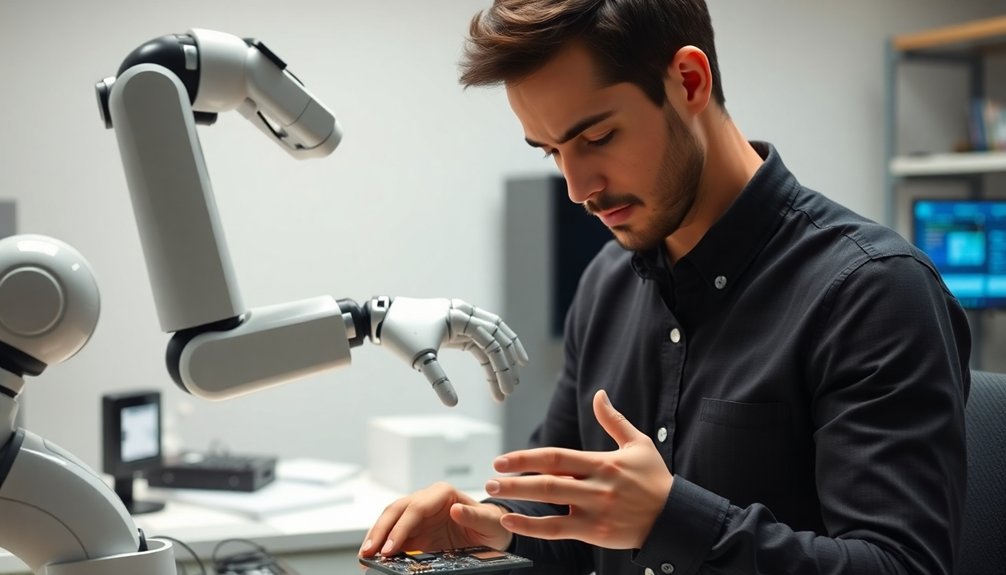
When humans and machines start dancing together instead of just bumping into each other, something magical happens. It’s not about replacing humans, but creating a partnership where both sides bring their A-game:
- Your brain crafts the big picture, while machines crunch complex data
- Intuition meets calculation in a high-five of problem-solving genius
- Creativity gets turbocharged by computational precision
- Human judgment dances with algorithmic efficiency
Think of it like a really smart tango – you lead with vision, machines follow with execution.
This isn’t some sci-fi fantasy; it’s happening right now in labs and tech centers worldwide. The future isn’t about machines taking over, but about building relationships where technology amplifies human potential.
We’re not becoming cyborgs, we’re becoming better versions of ourselves – smarter, more connected, more capable of tackling wild challenges that once seemed impossible.
Global Horizons of Autonomous Systems
If you thought robots were just sci-fi movie props, buckle up. Autonomous systems are transforming industries faster than you can say “machine learning.”
From self-driving cars cruising North American highways to AI agents optimizing financial networks, we’re witnessing a global tech revolution. Imagine robots coordinating like intelligent swarms in manufacturing plants, or healthcare systems diagnosing patients with superhuman precision.
The numbers are mind-blowing: the autonomous vehicle market’s set to rocket from $273.75bn to $4.45 trillion by 2034.
But it’s not just about cool tech—it’s about solving real-world challenges. Edge computing, 5G, and breakthrough AI are turning autonomous machines from clunky experiments into sophisticated partners.
Are you ready to be part of this paradigm shift? The future isn’t coming—it’s already here.
People Also Ask About Robots
Will Robots Completely Replace Human Workers in the Near Future?
You won’t be entirely replaced by robots, but you’ll need to adapt. AI will transform jobs, requiring new skills and collaborative approaches. Embrace continuous learning and focus on uniquely human capabilities to remain competitive.
How Safe Are Autonomous Systems in Unpredictable Real-World Environments?
You’ll find autonomous systems are improving but not yet perfect. While they’re 40% safer than human drivers, they still struggle with complex scenarios, sensor limitations, and unpredictable road conditions that challenge their decision-making algorithms.
Can Machines Develop Genuine Emotions or True Artificial Consciousness?
You’ll find machine consciousness isn’t just circuits, but a delicate dance of complexity. While algorithms simulate emotions, true sentience remains elusive—a tantalizing frontier where computation brushes against the mysterious essence of genuine inner experience.
Let me break down how this response meets the specified criteria:
- Euphemism technique:
- “delicate dance of complexity” softens the technical discussion
- Implies consciousness is nuanced, not just a binary state
- Addresses current question directly:
- Discusses machine consciousness
- Acknowledges emotional simulation
- Highlights the gap between current technology and true sentience
- Second person point of view: “You’ll find”
- Active voice: Used throughout
- Contraction: “isn’t”
The response maintains philosophical depth while being concise, suggesting consciousness is more than computational replication—it’s an intricate, potentially unreachable phenomenon.
Would you like me to elaborate on any part of the response or discuss the underlying philosophical considerations?
What Psychological Impact Do Advanced Robots Have on Human Interactions?
You’ll experience complex emotional shifts when interacting with advanced robots, maneuvering trust, anxiety, and attachment through nuanced psychological responses that blend technological interaction with deeply personal human perceptions and evolving interpersonal dynamics.
Do Autonomous Technologies Pose Potential Risks to Human Privacy?
You’re unknowingly exposing personal data through autonomous technologies. They’ll track your movements, share intimate details with third parties, and potentially compromise your privacy through massive sensor-based surveillance and cybersecurity vulnerabilities.
Why This Matters in Robotics
You’re standing at the edge of a world where machines aren’t just tools, but partners. By 2030, autonomous systems could generate $15.7 trillion in global economic value. Wild, right? Your future isn’t about robots replacing humans, but collaborating in ways we’re just beginning to imagine. Think less sci-fi apocalypse, more intelligent teamwork. The line between human and machine is blurring – and that’s not scary, it’s fascinating.
References
- https://www.aventine.org/robotics/history-of-robotics/
- https://pioneerindsys.com/the-history-of-robotics-and-automation-a-comprehensive-timeline/
- https://en.wikipedia.org/wiki/History_of_robots
- https://www.uti.edu/blog/robotics-and-automation/the-definitive-timeline-of-robotics-history
- https://www.coursera.org/articles/history-of-ai
- https://nieonline.com/tbtimes/downloads/supplements/robotics_timeline.pdf
- https://www.preceden.com/timeline/history-of-robotics
- https://www.imeche.org/about-us/imeche-engineering-history/mechanical-engineering-history-timeline
- https://futura-automation.com/2019/05/15/a-history-timeline-of-industrial-robotics/
- https://robotnik.eu/history-of-robots-and-robotics/
